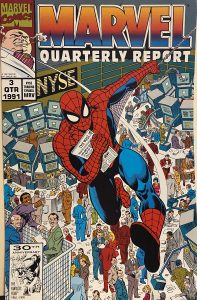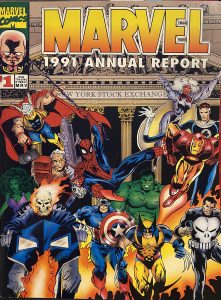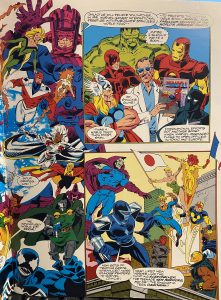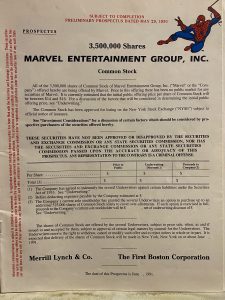Thirty years ago today, on December 17, 1991, a bombshell exploded in the worlds of comics, Wall Street, and the media.

After a spectacularly successful year in which, among other triumphs, Spider-Man #1 sold an unprecedented 2.5 million copies, owner Ronald Perelman launched an Initial Public Offering of Marvel Comics, raising more than $63,000,000. Gary Fishman, founder of a Wall Street investor and public relations firm and a lifelong comic book fan, contacted Marvel CEO Bill Bevins to see how he might help. Bevins’s first assignment for him: assist Marvel with its upcoming quarterly report to shareholders.
In a meeting with Marvel executives, including President Terry Stewart and CFO Robert Riscica, Fishman addressed the problem of how to communicate the unique and complex Marvel Comics Universe within a typically dry stockholder report. The solution they devised was to turn the report into a comic book starring Marvel superheroes. Working with editor Glenn Herdling, and using the Marvel Method of story to art to dialogue, Fishman developed the plot, Herdling found some of Marvel’s best artists to pencil, ink, and color, then Fishman wrote the copy (conveying everything the lawyers and SEC demanded), and Herdling put everything together. And so, thirty years ago today, a slim four-page comic debuted, with a cover by legendary artist John Romita Sr. Inside, Spider-Man and the Incredible Hulk (sporting, appropriately, an accountant’s green eye shade) discussed net income, publishing revenues, and earnings per share.

The report caused an immediate sensation. No one had seen anything like it. Even more impressive was the subsequent annual report. A 36-page stapled book on glossy paper, it combined information in comics form, introduced by Uatu the Watcher, with updates on licensing, advertising, and more, along with traditional financial tables and text. Artists included Jimmy Palmiotti, George Roussos, and John Romita Jr. Marvel’s comic book quarterly and annual reports received media coverage from Main Street to Wall Street, in the US and around the world, including The New York Times, USA Today, The Wall Street Journal, Financial Times, and Institutional Investor. They also won art and design awards from the International Academy of Communications Arts & Sciences and other organizations.

The success of the IPO and the reports spoke to the universal appeal of these costumed characters—which has only accelerated in our modern age—and also to an evolving social response to comic books, long thought of as disposable trash fit only for children.
Now, thanks to Gary Fishman’s generosity, as well as his recognition of the importance of these materials, RBML holds a complete set of all these reports, the “red herring” and final prospectuses for the IPO, newspaper and magazine articles, award certificates, and other related documents and publications, including a recent Back Issue magazine documenting the history and impact of Marvel’s shareholder reports. Fishman’s collection augments both our comics archives and also our holdings in the history of publishing. With the Marvel Cinematic Universe dominating both Hollywood and streaming television today, it’s fascinating to look back at one of the company’s earlier leaps toward cultural dominance.


2 thoughts on “Marvel Comics Shareholder Reports: A Marriage of Corporate and Creative”